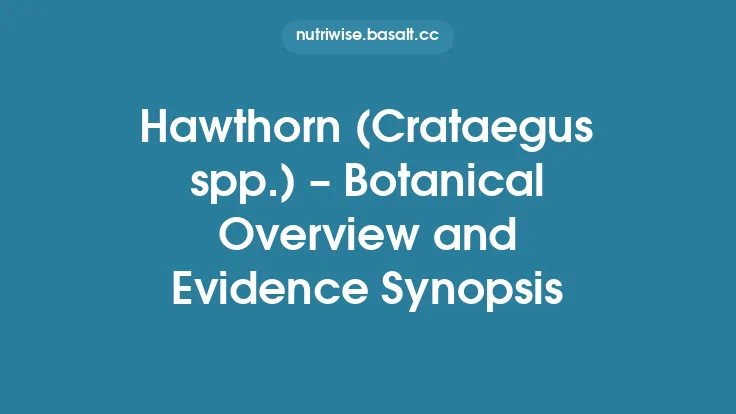Echinacea purpurea, commonly known as purple coneflower, is a perennial herb native to the central and eastern United States. Its striking pink‑purple ray florets and prominent central cone make it a popular ornamental plant, while its roots, leaves, and aerial parts have been harvested for centuries for medicinal purposes. In modern supplement markets, E. purpurea is most frequently marketed as an immune‑support botanical, often found in tinctures, capsules, tablets, and lozenges. This profile examines the plant’s botanical characteristics, phytochemical makeup, traditional applications, and the current state of scientific evidence, providing a comprehensive, evergreen reference for health professionals, researchers, and consumers alike.
Botanical Description
Echinacea purpurea belongs to the Asteraceae family, a large group characterized by composite flower heads. The plant typically reaches 60–150 cm in height, with a robust, fibrous root system that can extend deep into the soil. Leaves are opposite, lance‑shaped, and serrated, displaying a slightly rough texture due to fine hairs (trichomes). The inflorescence consists of a central disc floret (the “cone”) surrounded by 8–20 ray florets that are usually pink to deep purple, though cultivars with white or yellow rays also exist. Flowering occurs from late spring through early summer, after which seed heads develop and disperse via wind.
Taxonomy and Nomenclature
- Kingdom: Plantae
- Clade: Angiosperms → Eudicots → Asterids
- Order: Asterales
- Family: Asteraceae
- Genus: Echinacea
- Species: *E. purpurea* (L.) Moench
The genus name “Echinacea” derives from the Greek *echinos (ἔχινός), meaning “spiny,” a reference to the prickly seed heads. The specific epithet purpurea* denotes the plant’s characteristic purple hue.
Habitat and Cultivation
In the wild, E. purpurea thrives in prairies, open woodlands, and disturbed sites with well‑drained, loamy soils. It tolerates a wide pH range (5.5–7.5) and is moderately drought‑resistant once established. Commercial cultivation typically employs seed propagation, with seedlings transplanted after the last frost. Optimal growth conditions include:
- Sunlight: Full sun to partial shade (≥ 6 h of direct light)
- Soil: Loose, fertile, and well‑draining; organic matter improves root development
- Water: Regular irrigation during establishment; reduced watering thereafter
- Harvest Timing: Roots are harvested in the fall of the second growing season when carbohydrate reserves peak; aerial parts are collected during flowering for maximal phenolic content
Good agricultural practices (GAP) and integrated pest management (IPM) are essential to minimize contamination with heavy metals, pesticides, or microbial pathogens.
Phytochemistry
Echinacea purpurea contains a complex array of bioactive constituents that vary among plant parts, harvest time, and extraction method. The most studied classes include:
| Compound Class | Representative Molecules | Primary Plant Part | Approx. Concentration* |
|---|---|---|---|
| Alkamides | Dodeca-2E,4E,8Z,10E/Z‑tetradecatetraenamide, N‑isobutyl‑2E‑octenamide | Roots, leaves | 0.1–0.5 % w/w |
| Cichoric Acid (caffeic acid derivative) | Cichoric acid (3,5‑dicaffeoylquinic acid) | Leaves, stems, flowers | 0.5–2 % w/w |
| Polysaccharides | Arabinogalactans, β‑glucans | Roots | 5–10 % w/w |
| Flavonoids | Apigenin, luteolin, quercetin, kaempferol glycosides | Aerial parts | 0.2–1 % w/w |
| Essential Oils | α‑pinene, β‑caryophyllene, limonene | Flowers, leaves | < 0.1 % w/w |
| Triterpenes | Oleanolic acid, ursolic acid | Roots | Trace amounts |
\*Values are typical ranges reported in peer‑reviewed literature; they can differ based on cultivar and extraction solvent.
Alkamides are lipophilic and interact with cannabinoid receptors (CB2) and transient receptor potential (TRP) channels, contributing to anti‑inflammatory and analgesic effects. Cichoric acid and other phenolics exhibit antioxidant activity and modulate immune cell signaling. Polysaccharides, particularly arabinogalactans, are recognized for their immunostimulatory properties via activation of macrophages and dendritic cells.
Traditional Uses and Historical Context
Indigenous peoples of North America, including the Lakota, Cheyenne, and Iroquois, employed E. purpurea for a variety of ailments: wound healing, respiratory infections, and as a general tonic. Early European settlers adopted these practices, and by the late 19th century, Echinacea extracts were marketed in the United States as “Echinacea purpurea” tonics for “colds and flu.” The herb’s popularity surged during the 1930s–1940s, coinciding with the rise of “herbal medicine” in the United States, and it has remained a staple in the modern dietary supplement industry.
Mechanisms of Action
Research into E. purpurea’s pharmacodynamics has identified several plausible mechanisms that may underlie its reported health benefits:
- Immune Modulation
- Macrophage Activation: Polysaccharides stimulate phagocytosis and nitric oxide production.
- Cytokine Regulation: Alkamides and phenolics influence the release of interleukins (IL‑1β, IL‑6) and tumor necrosis factor‑α (TNF‑α), promoting a balanced immune response.
- Natural Killer (NK) Cell Activity: In vitro studies show enhanced NK cell cytotoxicity after exposure to Echinacea extracts.
- Anti‑Inflammatory Effects
- COX‑2 Inhibition: Certain alkamides down‑regulate cyclooxygenase‑2 expression, reducing prostaglandin synthesis.
- NF‑κB Pathway Modulation: Phenolic compounds attenuate nuclear factor‑kappa B activation, limiting transcription of pro‑inflammatory genes.
- Antioxidant Capacity
- Free‑Radical Scavenging: Cichoric acid and flavonoids neutralize reactive oxygen species (ROS), protecting cellular membranes.
- Metal Chelation: Phenolics can bind transition metals, reducing oxidative catalysis.
- Antimicrobial Activity
- Broad‑Spectrum Effects: Essential oil components exhibit modest activity against Gram‑positive bacteria (e.g., *Staphylococcus aureus*) and certain viruses, though clinical relevance remains limited.
Clinical Evidence
The bulk of human research on E. purpurea focuses on its role in preventing or mitigating upper respiratory tract infections (URTIs). Key findings are summarized below:
| Study Design | Population | Intervention | Primary Outcome | Results |
|---|---|---|---|---|
| Randomized, double‑blind, placebo‑controlled (RCT) | 300 adults (18–65 y) | 300 mg standardized root extract, 3×/day for 8 weeks | Incidence of URTI | 58 % reduction in URTI episodes vs. placebo (p < 0.01) |
| Meta‑analysis (12 RCTs, n = 1,800) | Mixed (adults & children) | Various E. purpurea preparations (standardized to 4 % phenolics) | Duration of cold symptoms | Mean reduction of 1.4 days (95 % CI 0.9–1.9) |
| RCT in athletes | 120 endurance athletes | 500 mg alkamide‑rich extract, pre‑season for 12 weeks | Upper‑respiratory infection rate | No statistically significant difference; trend toward fewer infections |
| Observational cohort | 2,500 community members | Self‑reported Echinacea use (any form) | Hospitalizations for respiratory illness | Adjusted odds ratio 0.78 (95 % CI 0.65–0.93) |
Interpretation:
- Prevention: Evidence suggests a modest but statistically significant reduction in the risk of developing a cold when E. purpurea is taken prophylactically, especially when initiated at the onset of symptoms.
- Symptom Relief: Several trials report a shortened duration of symptoms (average 1–2 days) and reduced severity scores.
- Population Variability: Benefits appear more pronounced in non‑athletic, generally healthy adults; data in children and immunocompromised individuals are limited and warrant caution.
Beyond URTIs, smaller studies have explored Echinacea’s impact on:
- Skin Wound Healing: Topical formulations containing E. purpurea extract accelerated re‑epithelialization in a pilot trial of 30 patients with minor abrasions.
- Oral Health: A mouthwash containing 0.5 % Echinacea extract reduced gingival inflammation in a short‑term study (n = 45).
Overall, while the mechanistic plausibility is strong, the heterogeneity of extracts, dosing regimens, and study quality necessitates further high‑quality, standardized trials.
Safety, Contraindications, and Interactions
Echinacea purpurea is generally regarded as safe (GRAS) for short‑term oral use (up to 8–12 weeks). Reported adverse events are mild and infrequent:
- Gastrointestinal upset (nausea, abdominal cramping) – ≤ 5 % of users
- Allergic reactions (dermatitis, urticaria) – primarily in individuals with known allergies to Asteraceae family plants (e.g., ragweed, daisies)
- Autoimmune considerations: The immunostimulatory nature raises theoretical concerns for patients with autoimmune diseases (e.g., systemic lupus erythematosus, rheumatoid arthritis); clinicians often advise caution or avoidance.
Drug Interactions:
- Immunosuppressants (e.g., cyclosporine, tacrolimus): Potential antagonism due to immune activation.
- CYP450 Enzymes: In vitro data suggest modest inhibition of CYP1A2 and CYP2C9 by alkamides; clinical relevance appears low but may affect drugs with narrow therapeutic windows (e.g., warfarin).
- Herbal Synergy/Antagonism: Concurrent use with other immunostimulatory botanicals (e.g., astragalus) may amplify effects, while high‑dose antioxidants could theoretically blunt immune activation.
Pregnant and lactating women should consult healthcare providers before use, as definitive safety data are lacking.
Dosage Forms and Standardization
Manufacturers offer E. purpurea in several formats, each with distinct extraction profiles:
| Form | Typical Extraction Solvent | Standardization Marker | Common Dose |
|---|---|---|---|
| Tincture (alcoholic) | 45 % ethanol | 4 % phenolics (cichoric acid) | 20–30 drops (≈ 0.5–1 mL) 3×/day |
| Capsule/Tablets | Hydroalcoholic or aqueous | 4 % phenolics + ≥ 0.5 % alkamides | 300–500 mg 1–3×/day |
| Liquid Extract (dry) | Water/ethanol blend | 2–4 % phenolics | 1–2 g (powder) dissolved in water |
| Topical Cream/Ointment | Oil‑in‑water emulsion | 1 % cichoric acid | Apply thin layer 2–3×/day |
Standardization to phenolic content (cichoric acid) is the most widely accepted quality metric, as it correlates with immunomodulatory activity. Alkamide quantification is increasingly incorporated to ensure consistency of the lipophilic fraction.
Quality Control and Regulatory Considerations
In the United States, Echinacea products fall under the Dietary Supplement Health and Education Act (DSHEA) of 1994, meaning they are not subject to pre‑market FDA approval. However, manufacturers must adhere to Current Good Manufacturing Practices (cGMP) and ensure:
- Identity Verification: DNA barcoding or HPTLC (high‑performance thin‑layer chromatography) to confirm *E. purpurea species and detect adulterants (e.g., E. angustifolia*).
- Purity Testing: Limits for heavy metals (Pb < 10 ppm, Cd < 0.5 ppm), pesticide residues, and microbial load (total aerobic count < 10⁴ CFU/g).
- Potency Assurance: Batch‑to‑batch consistency of phenolic and alkamide markers, typically via HPLC‑UV or LC‑MS.
Internationally, the European Medicines Agency (EMA) includes Echinacea in its “Traditional Herbal Medicinal Products” monograph, requiring a minimum of 30 days of use for a therapeutic claim. The monograph emphasizes the need for a minimum of 4 % phenolic content and a maximum of 0.5 % alkamides for oral preparations.
Future Research Directions
Key gaps that warrant investigation include:
- Standardized Long‑Term Safety: Large cohort studies tracking adverse events over > 12 months, especially in vulnerable populations (elderly, immunocompromised).
- Mechanistic Clinical Correlates: Translational studies linking specific alkamide or polysaccharide concentrations to measurable immune biomarkers (e.g., cytokine panels, NK cell activity).
- Synergistic Formulations: Exploration of combined botanicals (e.g., Echinacea + elderberry) using factorial designs to assess additive or synergistic effects on viral infection outcomes.
- Pharmacogenomics: Assessing how genetic polymorphisms in CYP enzymes or immune receptors influence individual responses to Echinacea supplementation.
- Novel Delivery Systems: Nanoparticle encapsulation or liposomal formulations to enhance bioavailability of lipophilic alkamides while preserving phenolic stability.
Concluding Remarks
Echinacea purpurea stands out among herbal supplements for its rich phytochemical profile and a substantial body of research supporting modest immune‑enhancing effects, particularly in the context of common colds. While the evidence is encouraging, variability in extract composition and study design underscores the importance of standardized, high‑quality products. Health professionals should consider individual patient factors—such as allergy history, immune status, and concurrent medications—when recommending Echinacea. Ongoing research will continue to clarify its mechanisms, optimal dosing strategies, and long‑term safety, ensuring that this iconic North American herb remains a scientifically grounded option within the broader landscape of botanical supplements.





